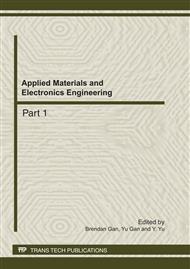p.719
p.723
p.727
p.731
p.735
p.740
p.744
p.748
p.752
Direct Reactive Compatibilization of GMA on PE/Wood-Flour Composite
Abstract:
Reactive compatibilization between high-density polyethylene(HDPE) and wood-flour was achieved via direct reactive extrusion of glycidyl methacrylate(GMA), initiator, HDPE and wood-flour. Impact rupture surface of the composite was observed by scanning electron microscope(SEM), and its load deformation temperature(HDT) and mechanical properties were tested. Effect of GMA dosage and extrusion temperature on reactive compatibilization of the composite was analysed. The result indicated that the anchoring strength of interface in the composite was obviously strengthened, and its HDT, tensile strength, flexural strength, notched impact strength and elongation at break of the composite were distinctly improved due to the addition of GMA and dicumyl peroxide(DCP). When the composite was extruded at 180°C, the peak values of its HDT, tensile strength, flexural strength, elongation at break and notched impact strength respectively were 84°C, 40Mpa, 45Mpa, 11% and 6.6KJ.m-2, which respectively increased by 17°C, 74%, 36%, 83% and 69% than that of the composite without reactive compatibilization, and when the composite was extruded at 190°C, the peak values of its HDT, tensile strength, flexural strength, elongation at break and notched impact strength respectively were 84°C, 40Mpa, 44Mpa, 11% and 6.6KJ.m-2, which respectively increased by 20°C, 60%, 26%, 83% and 83% than that of the composite without reactive compatibilization. When GMA usage increased, the HDT and mechanical properties of the composite increased first, then descended, and the optimum usage of GMA was 1wt%-3wt%.
Info:
Periodical:
Pages:
735-739
Citation:
Online since:
October 2011
Authors:
Price:
Сopyright:
© 2012 Trans Tech Publications Ltd. All Rights Reserved
Share:
Citation:


